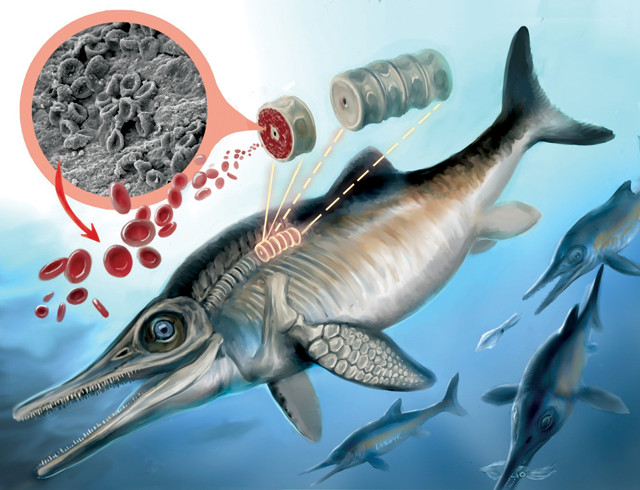
by Mary Caperton Morton Friday, February 23, 2018

The oldest preserved red blood cells, white blood cells and platelets have been found in the remains of a 183-million-year-old ichthyosaur vertebra. Ichthyosaurs were formidable marine predators in Mesozoic seas. Credit: Curtin University.
Since 2005, a steady trickle of reports detailing proteins and other soft tissues preserved in fossils of dinosaurs and other ancient animals has gradually worn down the disbelief that such tissues can last through geologic time. In a new study in Scientific Reports, scientists have now reported the oldest preserved red blood cells, white blood cells and platelets, found in the remains of an ancient marine reptile.
Carbonate concretions, formed when minerals precipitate from fluids that trickle into void spaces in existing rocks, are known to sometimes form around exceptionally well-preserved fossils. One such concretion found in southwest Germany, dating to about 183 million years ago, formed around a vertebra from a Stenopterygius, a type of ichthyosaur that lived in the Early Jurassic. Analysis of the fossil with transmission electron microscopy revealed organic structures similar to red blood cells. Further imaging and molecular investigations identified these structures as red and white blood cell-like structures as well as platelet-like structures, collagen and cholesterol. Collagen from a 195-million-year-old dinosaur and cholesterol from a 380-million-year-old crustacean have previously been reported, but these are the oldest preserved blood cells.
The team, led by Chloé Plet of Australia’s Curtain University, also reported that the preserved red blood cells were four to five times smaller than modern red blood cells. “We propose that the small size of the blood cell-like structures results from an evolutionary adaptation to the prolonged low-oxygen atmospheric levels prevailing during the 70 million years when ichthyosaurs thrived,” the researchers wrote.
© 2008-2021. All rights reserved. Any copying, redistribution or retransmission of any of the contents of this service without the expressed written permission of the American Geosciences Institute is expressly prohibited. Click here for all copyright requests.